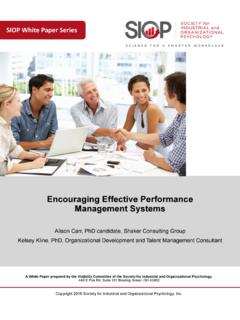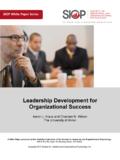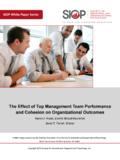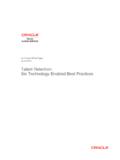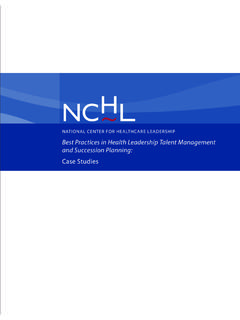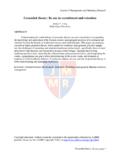Transcription of Trends and Practices in Talent Analytics - Welcome …
1 Trends and Practices in Talent Analytics Jasmit Kaur University of Michigan Alexis A. Fink Intel Copyright 2017 Society for Human Resource Management and Society for Industrial and Organizational Psychology SHRM-SIOP Science of HR White Paper Series Jasmit Kaur University of Michigan Jasmit Kaur completed a master s program in information analysis and retrieval (data science) and human computer interaction (UX research and design) at the University of Michigan, Ann Arbor in 2017. Her interests include working in the intersection of HR, data, and technology, which led her to found Culturebie, a Talent Analytics product company. From 2005 to 2014, she worked at Microsoft in several roles in HR.
2 Her last role at Microsoft involved working on Talent Analytics data to develop the annual HR strategy for the sales and marketing business of the company, implementing leadership development programs for sales leaders, and program management of global HR projects in Talent Management. Prior to Microsoft, Jasmit worked as a management consultant with PricewaterhouseCoopers where she focused on large-scale change management projects involving energy infrastructure development, poverty alleviation and e-governance, funded by the World Bank, UK Department for International Development (DFID), and the Asian Development Bank. Jasmit received her MBA from XLRI School of Management (India) in 2003.
3 Alexis Fink Intel Alexis A. Fink, , has been leading Talent Analytics organizations for over a decade, most recently as General Manager, Talent Intelligence Analytics at Intel. There, her organization works at the leading edge of data-driven Talent Practices and provides original organizational effectiveness research, Talent Analytics , Talent marketplace Analytics , HR systems and tools, and strategic workforce planning. Prior to Intel, Alexis spent seven years at Microsoft, where her roles included director of Talent management Infrastructure. Her career has been characterized by an integrative approach to HR, including developing and implementing competency systems and integrated Talent management systems.
4 Her background also includes work in large-scale organizational transformation and managing acquisitions. Alexis earned her in industrial/organizational psychology and is a Fellow of the Society for Industrial and Organizational Psychology (SIOP). In addition to practicing and leading in organizations, she continues to teach, is a frequent SIOP contributor, and an occasional author and journal editor. i Executive Summary What kind of work is being done in Talent Analytics ? What is required to set up and run an effective Talent Analytics function? These are the questions that we sought to answer through 22 interviews with academics, consultants and practitioners from a mix of industries (technology, banking, automobile and pharmaceutical).
5 What kind of work is being done in Talent Analytics ? Recognition of the value of Talent Analytics is accepted by both business leaders and the human resource (HR) community. Some fundamental Practices are widespread: reporting infrastructure, dashboard for HR metrics and employee surveys. About half of the organizations in our sample also perform statistical analysis and modeling of data, and a few have exceptional Practices worth emulating. However, most organizations have a fragmented or inconsistent approach to Talent Analytics . Existing problems include a lack of adequate skills and resources and competing priorities that hold back practitioners from more advanced Analytics . Advanced technologies such as machine learning and artificial intelligence (AI) are still in an experimental phase in HR.
6 Apart from skills and resources, obstacles include ABSTRACT Increasingly, organizations are investing in or upgrading their efforts in Talent Analytics . Based on 22 interviews with academics, consultants and practitioners at 16 corporations and other Talent Analytics experts, this paper offers a review of key approaches, competencies and tools. Examples of sophisticated Talent Analytics projects to address human resource challenges and organizational dynamics are also provided. We find that successful Talent Analytics depends on mandates, structure and operationalization, and responses to obstacles. By classifying Talent Analytics work into three broad categories data infrastructure and reporting, advanced Analytics , and organizational research we offer a high-level roadmap for building and growing the Talent Analytics function.
7 Ii the unavailability of clean data, which, in turn, results from spotty quality control or legacy HR systems. What is required to set up and run an effective Talent Analytics function? Talent Analytics teams, especially when serving organizations of more than 1,000 employees, tend to have in-house or borrowed data analysis skill, knowledge of industrial/organizational (I/O) psychology and good IT support. The most successful Talent Analytics teams tend to report directly to HR leadership and centralize research and Analytics . It is also important for Analytics to be a visible part of the HR strategy of the chief human resource officer (CHRO). Centralized Analytics enables an organization-wide view, which leads to greater impact.
8 However, even with a centralized Talent Analytics function, close partnership with line HR is imperative. It enables better contextualization of data and improves the data-oriented mindset throughout HR. Finally, HR practitioners must consider ethical and legal considerations of data collection and decision-making. Based on a snapshot of the 16 companies, together with the content of our interviews and literature review, we reveal potential trajectories for building and growing a Talent Analytics function. Our analysis finds three components of a mature Talent Analytics function: 1) data infrastructure and reporting, 2) advanced Analytics , and 3) organizational research. Data infrastructure and reporting are the obvious place to start for most companies.
9 It is difficult to do more advanced Analytics or research without a clean, well-organized body of data on which at least basic statistics and trend analyses can be performed. iii Advanced Analytics refers to the use of more sophisticated analytical tools often applied to a more diverse set of data to arrive at deeper insights. For example, correlations between employee satisfaction surveys and standard HR data (such as salaries and promotion rates) may allow predictive modeling of employee retention and attrition. Organizational research refers to scientific studies about HR issues that often have implications beyond a single company. It seeks to answer questions such as these: What are the distinguishing traits of effective teams?
10 Why are women underrepresented in leadership? What are the best methods for recruiting new hires? We find that after data infrastructure and reporting, the next step can be either advanced Analytics or organizational research. Either way, additional data Analytics capacity that is beyond traditional HR training is required. Some mature Talent Analytics functions concentrate resources on just one or the other (advanced Analytics or organizational research); others eventually opt for the full complement of Talent Analytics capability. While there is no one-size-fits-all solution for building a high-performance Talent Analytics function, an understanding of strong models and recent Trends can inform next steps for any organization.
